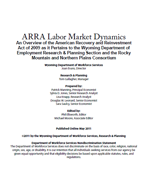
State Level Legislation Regarding Energy-Efficient Technologies
Occasional Paper No. 5
ARRA Labor Market Dynamics An Overview of the American Recovery and Reinvestment Act of 2009 as it Pertains to the Wyoming Department of Employment Research & Planning Section and the Rocky Mountain and Northern Plains Consortium

The full document is available online here.
- Chapter 1.
- Definition(s) of "Green" Jobs
- Chapter 2.
- A Review of Alternative Energy and Environmental Enhancement Technologies (Excerpted in June 2011 Trends)
- Chapter 3.
- State Level Legislation Regarding Energy-Efficient Technologies
- Chapter 4.
- Legislation and Regulatory Landscape Regarding EE Technologies (See article, page 15)
- Chapter 5.
- Results of the Baseline Survey (Article in February 2011 Trends)
- Chapter 6.
- A Summary of the New Hires Survey (Article in February 2011 Trends)
- Chapter 7.
- Text Mining Analysis of the New Hires Survey
- Chapter 8.
- Wyoming IMPLAN Analysis of ARRA Spending (Article in October 2010 Trends)
A previous article in this series (see ARRA Dynamics in the Labor Market, June 2011 Trends) reviewed some of the alternative energy and environmental enhancement technologies currently available or in the design or pilot program stage. For these technologies to be introduced or expanded in an efficient and socially responsible manner, the appropriate legislation must be in place to ensure they are implemented smoothly. For example, wind power generation in Wyoming has expanded greatly in recent years. If this is to continue, property rights must be established and maintained, siting requirements must be created and enforced, and habitat for protected species (e.g. sage grouse) must be maintained. The following sections discuss some of the legislation in Wyoming that will affect the implementation of these technologies.
In some areas, Wyoming may lag behind states such as California and Washington in the implementation of renewable energy and pollution-abatement initiatives. However, Wyoming has been proactive in addressing some of the issues regarding carbon capture and sequestration and wind energy production in the state. For example, state law in 2008 established that surface owners own underground storage rights, and specified that the Wyoming Department of Environmental Quality would oversee permitting for geologic sequestration (Wyoming Annotated Statutes, 2008a and 2008b). In 2010, legislation was approved mandating the Wyoming Department of Environmental Quality (DEQ) adopt rules and regulations requiring bonding and financial assurances for geologic sequestration site permit holders. (Wyoming Annotated Statutes, 2010a and 2010b). Regarding wind power generation, the construction of wind farms has sometimes led to conflicts regarding property rights issues. Chapter 47 from the 2010 Session expands the Industrial Siting Council's (ISC) authority to regulate wind farms with 30 or more towers (and other energy facilities that produce 160,000 volts or more). Thus a permitting process is required to assess potential environmental impacts and impacts on local employment ( p.221-231). Chapter 97 - (County Regulation of Wind Energy Development) requires that a wind facility of 0.5 megawatts or greater be required to apply for a permit in a given county. Permit applications are to include information on waste management plans, emergency management plans, sufficient proof of legal access to the site, and project plans. The act also requires the ISC to adopt rules regarding the decommissioning and reclamation of wind energy facilities.
References
Wyoming Annotated Statutes, (2008a) § 30-5-501. Oil and gas activities at geologic sequestration sites.
Wyoming Annotated Statutes, (2008b) § 35-11-101 et seq.
Wyoming Annotated Statutes, (2010a) § 35-11-318. Geologic sequestration special revenue account.
Wyoming Annotated Statutes, (2010b) § 35-11-313. Carbon sequestration; permit requirements.
